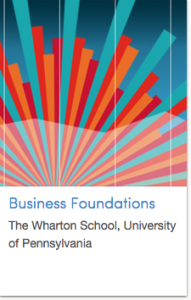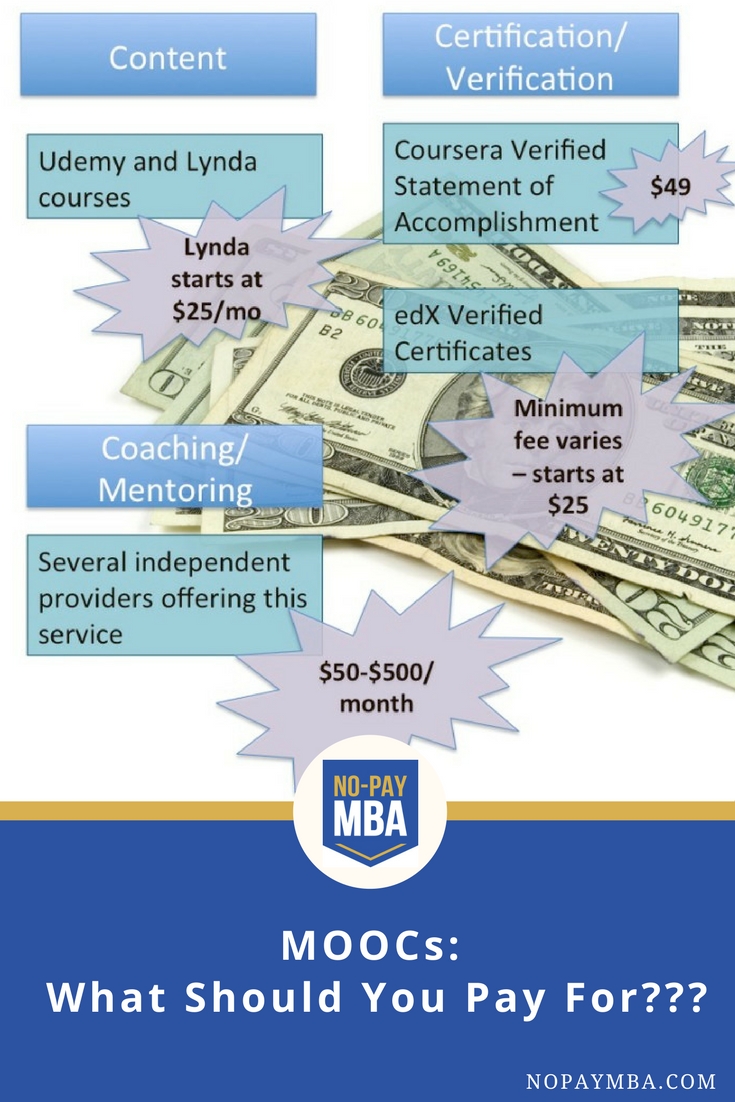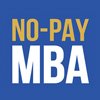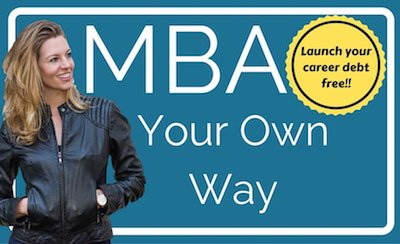by Laurie Pickard | Apr 2, 2015 | MOOC MBA Design

As degrees go, the MBA is a generalist degree; the education is far broader than it is deep. Most MBA programs require a wide variety of core courses, covering everything from financial analysis and decision-making to operations management, marketing, and strategy. While a two-year program couldn’t possibly turn its graduates into experts in all of these areas, most programs do require their students to select an area of concentration in which they build expertise through coursework and assignments.
When I started my No-Pay MBA, I didn’t have a concentration in mind. Like many first-year MBA students, I went into the program with an open mind and a goal of getting a strong foundation of key business skills and concepts.
In order to cover the topic of entrepreneurship, one of the courses I took early in my business education was Steve Blank’s How to Build a Startup, from Udacity. From the first video lecture, I was hooked. Here was a way of thinking, solving problems, and helping people that was completely new to me - and totally captivating. Over the subsequent year, I developed an almost unintentional concentration in entrepreneurship; every time I become aware of an entrepreneurship course, I couldn’t help but register for it. I’ve taken courses on entrepreneurship in subsistence economies; a course called Beyond Silicon Valley: Entrepreneurship in Transitioning Economies; and I’m currently dual-enrolled in my fourth and fifth entrepreneurship courses – Entrepreneurship 101 and 102 from MIT’s Sloan School of Business.
If you’ve been reading the blog or any of the news coverage of this project, then you know that I am planning to launch a business supporting people who would like to use MOOCs to get an MBA education. Given the number of entrepreneurship course I’ve taken, and the fact that I’m now starting a business, it’s probably time to make it official:
My MBA concentration is in entrepreneurship.
If you join me in this project, I’ll provide plenty of recommendations on how to put together your own No-Pay MBA, including choosing and building a concentration. For those who are already studying business via MOOC, here are a few tips on how to fit a concentration into a MOOC-based MBA equivalent.
1. When starting your MBA studies, take a variety of courses. One of the great advantages of MOOC-based education is the low cost of changing your mind. Take full advantage of that freedom by not nailing down your entire course of study too early on. Whether you’ve budgeted 18 months or three years to finish your studies, the time to choose a concentration is in the second half of your program. It’s clear to me now that entrepreneurship is the right concentration for me, but I couldn’t have told you that at the outset of my studies; it was a process of discovery.
2. Aim to complete at least 4 courses in your concentration, preferably 5 or more. This may require some creativity and some timing, as not all courses are available at all times. For some fields of study you may need to look outside of the major MOOC platforms to find the content you need.
3. Don’t limit yourself to the traditional MBA concentration areas. Another great benefit of studying via MOOC is that you get to have full control over your curriculum. Traditional MBA programs offer a wide variety of concentrations to students. Some of the more common concentrations include corporate finance, marketing, strategy consulting, general management, and entrepreneurship. But no matter how many options a traditional MBA program gives you in terms of concentration, your MOOC-based program can be even more tailored, personal, and specific than even the most flexible of the traditional MBA programs. Choose a concentration that matches your career aspirations.
4. Do at least one real-world project - preferably more – that directly relates to your area of concentration and puts your skills to work. Even before I knew I would be concentrating on entrepreneurship, I did a digital internship for a startup called Coursolve. I worked with the company to develop their strategy for entry into a new market. My current real-world project - building my own business - is also in part a learning experience related to my concentration. The important thing is to get hands-on experience. Whatever you learn in the classroom, it’s how you are able to take that knowledge out into the real world that will determine the true value of your education.
by Laurie Pickard | Mar 8, 2015 | Courses, Platforms, and Profs, MOOC MBA Design
This morning, I re-read Kevin Carey’s New York Times op-ed on what it will take for MOOCs to lead to real changes in higher education. At the end of the piece Carey says that we won’t feel the full impact of MOOCs “until students and learners of all kinds have access to digital credentials that are built for the modern world. Then they’ll be able to acquire skills and get jobs for a fraction of what colleges cost today.”
 I totally agree with Kevin Carey, and I think that the new Coursera Business Foundations Specialization – along with the rest of Coursera’s Specializations and other so-called microcredentials (Udacity’s Nanodegrees, edX’s Xseries) - are a digital credential of the type that Carey describes. Whether they enable people to get jobs remains to be seen, but with the participation of Shazam and Snapdeal on the Business Foundations Specialization, this credential takes a giant step forward in that regard.
I totally agree with Kevin Carey, and I think that the new Coursera Business Foundations Specialization – along with the rest of Coursera’s Specializations and other so-called microcredentials (Udacity’s Nanodegrees, edX’s Xseries) - are a digital credential of the type that Carey describes. Whether they enable people to get jobs remains to be seen, but with the participation of Shazam and Snapdeal on the Business Foundations Specialization, this credential takes a giant step forward in that regard.
Coursera is my go-to MOOC platform . They have more business courses than anyone else, and the courses I’ve taken from them have all been excellent. In particular, the Wharton Business School courses (I’ve taken three so far) have been among my all-time favorites.
But I’m not planning on signing up for the Business Foundations Specialization. And here’s why not.
It’s not because of the price.
Yes, $595 is a lot more than free, and yes, Coursera used to offer Verified Statements of Accomplishment for these same courses at about half of what they cost in this Specialization. But $595 is also a lot less than $25,000, which is what you would pay for the first semester of business school alone. I also appreciate that Coursera has kept the course material free, even while charging a fee to those who want the certificate, which covers not just the four courses but also a capstone project.
I don’t have any problem with paying for certificates or course content; the No-Pay MBA is not an ideological stance. I consider myself extremely lucky to have been able to take all of my courses for free thus far, but if I find I have to pay to get the content I need, I won’t think twice as long as the price is reasonable. As a business student, I also understand the need for the MOOC platforms to find a sustainable business model.
It’s not because I can’t get credit for the Wharton courses I’ve already taken, though if you paid for a Verified Statement of Accomplishment you can.
Changes in the course length and content are disappointing.
I didn’t realize that there was anything different between these courses and previous versions of the Wharton Foundation Series courses, until a reader pointed out to me that all of the new courses are only four weeks long. The previous versions were up to ten weeks, just like regular university courses. The reader who alerted me of this change also pointed me to a discussion board where students lamented the changes to Wharton’s Introduction to Accounting.
The professor of Intro to Accounting, Brian Bushee had a different take on the changes. He told me by email:
“For many students, four weeks will be enough. For the rest, the remaining six weeks of my old course will be available as an additional course. A nice feature of splitting the course in half like this is that students can take the second six weeks at any future point. They no longer have to commit to a ten-week block. With this added flexibility, I expect that more students will now be able to take the full ten weeks of material.”
I understand Professor Bushee’s point, but as a student I appreciated the fact that in Introduction to Accounting – and the other Wharton courses – I got most if not all of the content of the regular, on-campus course. But even that wouldn’t necessarily stop me from registering for the Specialization, especially given that the additional content is still available.
For certain people the Business Foundations Specialization could be the right digital certification.
If you’re planning to apply to Wharton or another business school having this Specialization under your belt could be a leg up. Or maybe you just need an introductory understanding of business and want a certificate to demonstrate that you’ve attained it.
The credential I need goes beyond Business Foundations.
I’d be happy to pay a few hundred dollars for a digital credential if I thought it could provide additional legitimacy to my studies or could materially advance my career. But given that my project is to do a whole MBA with MOOCs – on a very small budget – this particular certificate doesn’t offer enough value for the money, especially given that the content is not as robust as it once was.
Others who are studying business via MOOC, I’d be interested to hear your thoughts on the Business Foundations Specialization. Are you planning to register? Why or why not? Comments welcome.
by Laurie Pickard | Feb 28, 2015 | MOOC MBA Design, Thoughts on Higher Ed and Life

As the MOOC providers search for viable revenue models, the number of things you can pay for in the MOOC world has exploded. From subscription sites like Lynda, to micro-credentials like Udacity’s Nanodegrees and Coursera’s Specializations, the array of options is dizzying. None is as expensive as regular college credit, but fees for MOOCs now range from free with an option to pay $50 for a verified certificate (Coursera, edX), to upwards of $900 for a single course (NovoEd), to $200 per month for access to as many courses as you can handle (Udacity, Lynda).
In the early days of massive open online courses you couldn’t pay for a course or a certificate if you wanted to.
In my opinion, the proliferation of non-free options is a good thing; it is only by having sustainable business models that the MOOC platforms will be able to stay in existence and continue producing high-quality content.
But given that all of these products are new and unproven, as a MOOC student it can be confusing to sort through them.
What is your goal and how much can you afford?
Just over a year ago, an article about the No-Pay MBA went viral. The headline made reference to a figure of $1000, which was how much I planned to spend on my MOOC-based MBA equivalent. That original estimate of $1000 was actually what I planned to spend to build my website – including hosting, the price of the site itself, some help from people who know more about the internet than I, and other assorted fees associated with running a website. I had not at that time – and in fact I still haven’t – spent any money on courses themselves. To be precise, mine is not a $1000 education, but rather a free education with a $1000 website.
There are a lot more ways to spend $1000 on online learning now than there were a year ago, but the approach I would recommend hasn’t changed.
- First, get very clear about your goals.
- Second, determine how much money you can afford to spend to reach those goals.
- Finally, when deciding how to spend that money, look for those options that do some combination of the following:
- Give you access to specialized content
- Provide you the motivation to finish your courses
- Lend credibility to your studies
When I started this project, I didn’t need to pay for specialized content, since the content I needed was available for free. But I did need to find a way to bring credibility to my effort – and to stay motivated enough to see it through. Building a website was the best way to build credibility for online learning, and being accountable to my readers has been critical to maintaining the motivation I need to complete my courses.
Fortunately, you have many options when it comes to accessing specialized content, maintaining motivation, and building credibility. With those key principles in mind, here is my take on what you should pay for when it comes to online education.
Certificates and identity-verified certificates
What they are
Most MOOC platforms give certificates – free or paid – to indicate a student’s completion of a course. Coursera and edX also offer an identity-verified certificate to ensure that the student who holds the certificate is the person who did the work for the course.
How much they cost
Coursera and edX will give you a basic certificate for free. Future Learn and MiriadaX offer paid certificates (£29 and €40, respectively). Coursera’s identity-verified Statement of Accomplishment costs $49 per course. edX verified certificates are on a sliding scale, with prices typically starting at $25 or $50 per course.
Worth it?
If you need the extra motivation, yes. I’ve written a more detailed analysis of the value of identity-verified certificates, but when it comes to credibility, I don’t think these fancier certificates are worth the expense – unless paying for the certificate will give you the motivation you require to finish the course. Of course, you may want to support a non-profit like edX, or the course may be part of a longer series which requires identity-verification for the overall cert. Which brings me to the next option.
Micro-credentials
What they are
Series of courses packaged into sets. Udacity’s Nanodegrees are primarily for IT topics. Coursera has partnered with Wharton to offer a Business Foundations Specialization. edX offers a Specialization in Supply Chain Management.
How much they cost
Udacity charges $200 per month, so the more quickly you finish, the less you spend. Coursera charges $595 for its Business Foundations Specialization ($95 per identity-verified course certificate, plus $215 for a capstone project). edX charges $375 for the Supply Chain Management series.
Worth it?
A pretty good bet. Micro-credentials are still very new, but with employers now collaborating on their design, they are likely to look very good on a resume. Good enough to replace a degree? Not yet, but who knows what the future will bring.
Course content
What it is
Some sites require you to pay just to access their content. The most popular of these sites are Lynda, Udemy, and Udacity.
How much it costs
Varies significantly - $25 per month for a basic Lynda subscription, from $40 to $200 for most coursees on Udemy, $200 per month on Udacity.
Is it worth it?
Yes, if you can’t get the content for free somewhere else, and if you’ll use it consistently.
Mentorship/Coaching
What it is
Support from a tutor or coach as you work your way through the course content. Udacity offers limited coaching in its Nanodegrees. Sites like Thinkful and SlideRule specialize in coaching students through courses on coding and programming.
How much it costs
Part of the monthly fee on Udacity, SlideRule charges $400 per month, and Thinkful charges $500 per month. I offer more affordable packages, starting at $50 per month. You can learn more about No-Pay MBA coaching packages here.
Worth it?
Yes. Not many options exist yet for business students – this service is primarily geared towards IT courses – but having someone there to help you along is key to course completion, especially for difficult subjects.
by Laurie Pickard | Feb 9, 2015 | Career Development, Community and Networking, MOOC MBA Design, Most popular posts
I’m pleased to share a guest post by Nick Switzer, who offers a tremendous example of how a MOOC MBA can be even more valuable than a traditional MBA. For those considering a No-Pay MBA, I expect you’ll find his story as inspiring and intriguing as I did. Enjoy! -Laurie
Why I turned down a company-paid MBA for a No-Pay MBA
 Everyone pursuing a No-Pay MBA is doing so because they cannot afford a traditional paid, brick and mortar MBA, right? A No-Pay MBA is the only option; otherwise, we would all enroll in traditional MBAs, right?
Everyone pursuing a No-Pay MBA is doing so because they cannot afford a traditional paid, brick and mortar MBA, right? A No-Pay MBA is the only option; otherwise, we would all enroll in traditional MBAs, right?
Not necessarily.
I work for a fantastic company with great benefits. One of those benefits is tuition reimbursement. If I take university courses that pertain to my role at the company, then the company pays for my tuition. As an engineer transitioning to a more business-oriented engineering role, I needed some financial and business training. My managing director (let’s call him Steve) knew this, and during a one-on-one lunch he suggested that I pursue a traditional MBA, taking advantage of the company’s tuition reimbursement policy.
I was flattered. Steve was my manager’s manager, a role model in the company, and he was telling me that the company would fund my MBA! However, after some deliberation, I declined this offer in favor of a No-Pay MBA using Coursera and other MOOC providers.
Why did I do this? How could I turn down such a generous benefit from my company?
I’ll give you 5 big reasons.
1. I value my time with my family.
When I started my No-Pay MBA, my wife and I were expecting our first child. My wife was a successful marketing manager for a Fortune 500 company at the time, with no plans to leave her role after maternity leave. I was committed to supporting her career, our family development, and my own career. I did not think it was possible to both perform well at my job and be a supportive father and husband, all while attending MBA classes and studying.
With a No-Pay MBA, I watched half of each weeks’ lectures in the same amount of time I would have spent in traffic commuting to off-site classes. Often I would do my courses while my child was sleeping, either early in the morning or late at night.
In this way, MOOCs allowed me to maximize time with my family.
2. I needed to learn quickly and apply my skills immediately.
In my new role, I needed business strategy and finance understanding immediately! Time lost taking the GMAT, GRE, selecting a program and applying meant real business opportunities lost. Through MOOCs, I was able to access top educational content within minutes of choosing my courses!
By the time director Steve suggested I start a paid MBA, I had already started 2 courses that were paying dividends in the office.
I immediately applied principles learned in class in the workplace with many co-workers who had graduated with paid MBAs, honing my learning in real-life scenarios.
Unlike a traditional MBA, I have the ability to share course materials directly with my co-workers as well. This has resulted in empowering my project teams to learn principles on the fly, when they need them most.
3. I wanted to choose my courses based on what would be most helpful at work.
One of the things I love most about MOOCs is the ability to craft my own curriculum.
I have a passion for data-driven decisions, so I am taking a 10-course Data Science specialization from Johns Hopkins as a focal point in my No-Pay MBA.
This type of curriculum flexibility and the ability to take courses from multiple top universities is simply unbeatable.
This was also helpful to my company because I was able to take the courses I needed immediately. I needed financial analysis and negotiation strategy, and I was able to take those courses right away.
4. I saved my company a lot of money.
In the recession of 2008, many companies suspended their tuition reimbursment programs for at least 6 months. I did not want to see my further education as a financial burden to my company.
As a responsible employee of my company, I made a serious cost-saving decision in pursuing a No-Pay MBA. This was an easy point for my director to understand.
My company is still investing in me, more in time commitment than in cash. This investment has paid off quickly, as my No-Pay MBA has armed me with frameworks that allow me to attack problems quickly.
5. I want MOOCs to succeed!
I believe broad, low-cost access to excellent educational materials will help our world, enriching lives and offering new paths to personal achievement and more stable economic conditions.
I want my daughters to live in a world where they have access to top-notch education without going into significant debt.
I want to see MOOCs succeed. What better way to help this happen than as a living example of the power of low-cost online education?
The Results
 Since I started my No-Pay MBA, my wife and I have been fortunate enough to have two great little daughters. My wife has been promoted, and because our schedules aren’t in conflict, she has been able to go on several international work-trips while I take care of the kids after work.
Since I started my No-Pay MBA, my wife and I have been fortunate enough to have two great little daughters. My wife has been promoted, and because our schedules aren’t in conflict, she has been able to go on several international work-trips while I take care of the kids after work.
On the job, I use frameworks and concepts from my courses every day. Thanks to my No-Pay MBA, I am totally comfortable having high-level financial and business strategy discussions with graduates from traditional MBA programs. I have also earned a promotion since starting this adventure in non-traditional education.
Bottom line: a No-Pay MBA aligned better with my goals of work-life balance and prioritization of my family than a standard MBA would have. It has been fantastic for my family, for my company and for me.
Nick Switzer is an engineer, a German-English technical translator, and a lifelong learner. To see his complete MOOC MBA transcript, visit www.nickswitzer.us.
by Laurie Pickard | Nov 13, 2014 | MOOC MBA Design
The following post originally appeared on TopMBA, a site full of resources for prospective MBA students.
The first time I didn’t go to business school I was thoughtless. The second time I didn’t got to business school I was restless. But the third time I didn’t go to business school was the charm. With the benefit of hindsight, I can tell you that I approached my graduate education all wrong. While I believe that I got it right in the end - more on that later - I also believe that you can do better. So put down that GMAT prep book. There are a few things I strongly encourage you to do before you apply to a single MBA program.
How the No-Pay MBA was born
First, a bit about my educational path:
The first time I didn’t go to business school I got a master’s in geography. At the time it seemed like an easy choice; having spent a few years as a teacher in a broken school system, I was highly interested in urban issues. So I applied to an urban studies and geography program and was offered a full scholarship. A no-brainer. And that was precisely the problem. I didn’t take the time to think long and hard about what I would do after I got my degree. I was so excited to get back into the world of academia – where I could explore my intellectual curiosities, where it was so easy to understand the metrics by which I would be graded - that I didn’t even stop to think about why I needed another degree. What exactly was I preparing myself to do?
The second time I didn’t go to business school I joined the Peace Corps instead. When I finished my geography degree and prepared to reenter the workforce, one thing was very clear. I wanted an international career, and if that was going to happen, I would need to get started. By this time, I had been doing some part-time work for a business incubation startup, and the suite of business skills that I hadn’t learned in graduate school was starting to look quite attractive. There was a moment when I strongly considered getting a second graduate degree, an MBA. But the dream of an international career was too strong, and I didn’t want to wait any longer to pursue it.
The third and most recent time I didn’t go to business school, I benefited from serendipity. Some of the best business schools in the US and the world were just beginning to make their course content available via massive open online courses, or MOOCs. I saw an opportunity to create the education I had long desired practically for free and without taking time out of my burgeoning career in international development. In August of 2013, I became the first person to publicly seek to replicate the MBA education using free online courses, modeling my curriculum after the top business programs in the world.
As I said at the beginning of this post, ultimately I believe I made the right decision not to go to business school. However, I didn’t know that for certain until I was well into the business education I have acquired by other means. What follows are my recommendations on the analytical process anyone should undertake before enrolling in an MBA program, but especially if doing so will require going into debt.
What every prospective MBA student should do before applying
1. Get very clear on what you will do AFTER you complete your degree.
I don’t just mean identifying a field you would like to be in. Be very concrete. What are the job titles you are interested in? What does a typical day look like in those jobs? Which are the firms you might like to work for? What will your career progression look like? Which of the skills you will acquire in your MBA program are you most excited to put into practice? Which of your talents will you hone, and how exactly will you translate them into the world of work?
2. Next - and this is critical - talk to some people who do the job you think you might like to have.
Find out from them what it is like to do their job. Ask yourself if you would truly enjoy doing that type of work. Find out whether a degree is necessary to get hired and which type of degree - and from which schools – is considered most valuable. Find out what each person would have done differently if they could go back and do it all again. If any of your assumptions change at this point, go back to step one.
3. Run the numbers.
If you’re thinking of getting an MBA you must like to do analysis, since that is the bulk of what you will learn to do in an MBA program. Why not get started early? Take a crack at valuing your potential MBA investment. Yes, there are tons of articles on the ROI of the MBA degree, but what is your personal expected return?
Come up with some numbers. What is the starting salary among people who do the job you want to do? What is the average salary for people who have been doing it for a while? What are the top earners making, and how likely is it that you will be among them? How important is the rank of the business school you attend versus the fact that you have those three letters behind your name?
Don’t be one of the many MBA graduates who regrets taking on a mountain of student debt and ends up in a job they don’t love just to be able to pay it off. Do the math so that you can be sure you are making the right choice. If you don’t know how to do this type of analysis, take a MOOC on finance or use the MBA calculator I created after my first finance course.
Given that I didn’t plan to work on Wall Street, my decision not to get an MBA makes financial sense for me. This may or may not be the case for you. Find out for sure.
4. Really consider the alternatives.
What is it about the MBA degree that will be most valuable to you? Do you need the network? Do you need the pedigree? If you are going into finance or high-end consulting, the answer is probably yes. But if you are planning to create a startup, that may not be the case. What will your long-term path look like with a degree versus without one? Which will be more valuable to you in the long run - a degree or two more years of work experience?
Now you can write your applications
After you finish this analysis, you will have plenty of fodder for your admissions essays - or you’ll be ready to start down an alternative path. Either way, your investment of time and energy is bound to pay off.
by Laurie Pickard | Sep 7, 2014 | MOOC MBA Design, Thoughts on Higher Ed and Life

Most of the discussion about MOOCs and their advantages has focused on price (cheap or free) and teaching methodology (flipped classroom, lectures that can be viewed again and again). But as I am discovering, a MOOC-based learning program has two other much less-discussed advantages, especially for working professionals – customizability and immediacy.
As you know if you’ve been reading this blog, my goal is to mimic a traditional MBA education using MOOCs and other free resources. I’ve used the curricula of top MBA programs like Wharton, Harvard, and Stanford to come up with my list of courses and topics. (If this is something you’re interested in, you can find more info on my Curriculum page, or on the MBA Learning Pathway on SlideRule, which I helped to create). But recently I strayed from the traditional MBA curriculum to take a course on Social Psychology, and I’m very glad I did.
Somehow I managed not to take any psychology courses in college, despite having an interest in the subject and the fact that my roommates in both undergrad and graduate school were psych majors. It seemed like a hole in my education, and I thought a bit of education on the subject as might serve me while navigating interpersonal relationships in the world of work. Even though it isn’t a topic that is typically covered in business school, taking this course has convinced me that it should be. Social Psychology was packed with pearls of wisdom about perception, biases, and decision-making – all relevant to work in any office. One of the most interesting units was on group behavior, covering such phenomena as the Abilene Paradox, in which fears of non-conformity cause a group to arrive at a decision that no one actually thinks is a good idea. Being aware of this tendency and taking simple steps to counter it can actually prevent a group from going down an unproductive path.
Because I am setting my own curriculum, and because the entire universe of MOOCs is open to me, I am able to tailor my curriculum to very personal specifications and to include courses like psychology that aren’t covered in most MBA programs. I see this as being a great advantage of my chosen method of study.
My next set of courses also includes personally relevant offerings that aren’t always in the B-school lineup. One is Supply Chain and Logistics Fundamentals, the first in MITx’s long-awaited supply chain and logistics management series. The other is a course on evaluation of social programs from MITs Poverty Action Lab, which pioneered the use of randomized control trials for international development interventions. The latter, by the way, will be my first course on data analysis.
As I did with Social Psychology, I’m straying outside of a narrowly-defined business curriculum to take Evaluating Social Programs. While my overarching goal is to acquire a particular set of business skills, I am interested in any course with the potential to make me a better professional. As a designer of social programs and a consumer of program evaluations, my expectation is to be able to put what I learn in this course into practice in my current job. Which brings me to the second less-discussed advantage of a MOOC education – immediacy.
While I suppose any study-while-working program has this advantage, being able to use new knowledge and skills immediately in a real-world setting is enormously valuable for cementing what you’ve learned. MOOCs also offer another kind of immediacy – there is almost no cost to changing your mind. If you discover that a course is not what you were expecting, or doesn’t meet your needs, you can choose to study something different without waiting an entire semester and without losing any money. The only sunk cost is the time you’ve already put in to the course. In both of these ways, the feedback cycle on MOOCs is short. If, like me, you’re mapping out a series of MOOCs to achieve a larger educational goal, you can easily course correct if you need more or less of a certain topic, or if you discover gaps in your learning program.
I’m not sure how many “non-MBA” courses I’ll end up taking over the course of my studies, just as I’m not sure how many courses in finance I’ll include. It depends on the opportunities that arise and the learning needs I discover along the way.










